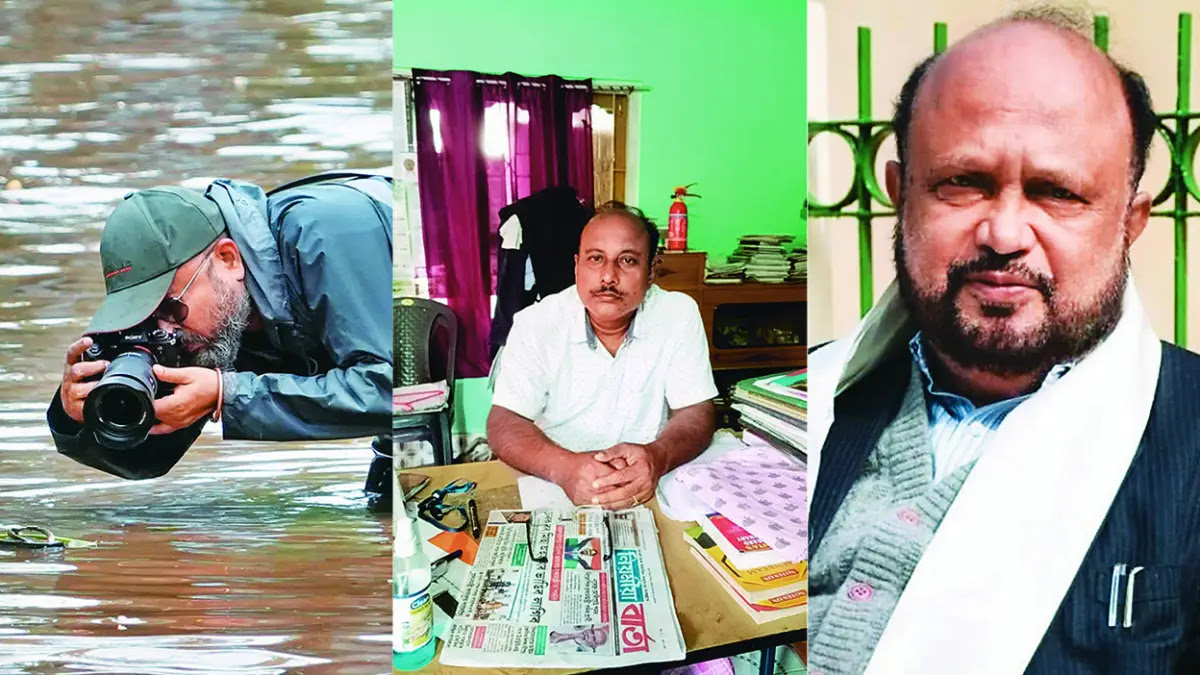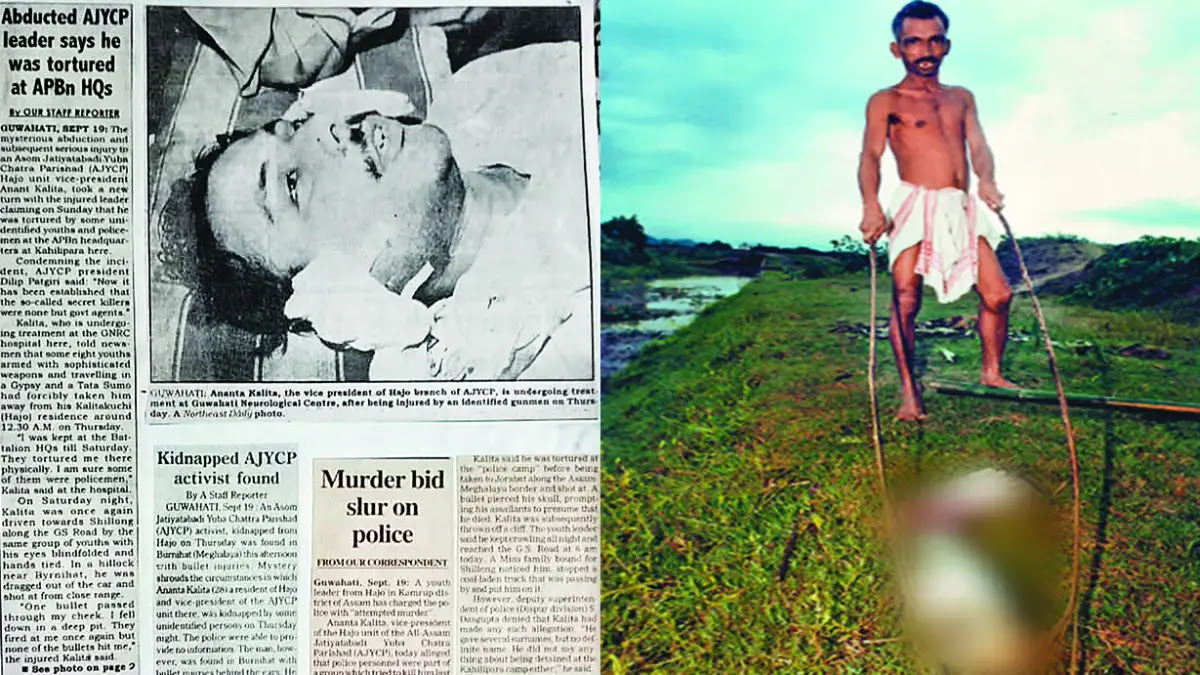Syeda Ambia Zahan
June 22, 1999. It was raining heavily when Anupam Nath, a young photo-journalist, reached an embankment on the Brahmaputra in Palashbari, a small town about 28 km from Assam’s capital city Guwahati. Nath and a colleague were following up on a tip about human remains being spotted along the dyke. But Nath, working with a Calcutta-based daily at that time, was not prepared for the chilling sight that would leave him shaken to his core. There, from among the water hyacinth, peeked out a severed human leg—neatly cut off at the knee. By then the rain had eased and he quickly snapped several pictures with his analog camera. Nath also did not know that he was documenting a dark chapter of Assam’s history. When the photographs were published in the next day’s edition, skeletons tumbled out and set off a chain reaction with far-reaching political and social ramifications.
Nath’s photograph became the first visual evidence, or any kind of evidence for the matter, of what has come to be known as ‘secret killings’—referred to as gupta hatya in Assamese—a series of undocumented killings over a period of four years, allegedly orchestrated by the state with the help of security forces between 1998 and 2001. The victims were mostly family members, relatives and anyone suspected to be a sympathiser of the outlawed United Liberation Front of Asam (ULFA), the insurgent group which claims to be fighting for a sovereign Assam.
Even before the photo and the subsequent new reports were published, there were horror stories floating in the air in Assam. Neighbours would gather discreetly and talk about bodies they saw while going to the paddy fields, severed body parts found in water bodies and in forested areas. But no one spoke out, afraid of ending up as victims themselves. Nath, now in his mid-40s, recalls the conversation he had with a woman on that day, just prior to his discovery. “The woman had said in a hushed tone that she and her husband often heard vehicles coming towards the embankment. They heard screams of people along with the sound of bullets being fired,” Nath tells Outlook. “But they were scared to go out and see what was going on.” Newsmakers (From left) Anupam Nath, Ananta Kalita and Prafulla Kumar Mahanta, all with ‘links’ to secret killings.
Newsmakers (From left) Anupam Nath, Ananta Kalita and Prafulla Kumar Mahanta, all with ‘links’ to secret killings.
But soon, the stories began to emerge. About armed masked men arriving in the dead of night to drag their victims out of their homes—often in front of their crying and pleading wives and children—and taken to unknown destinations in vehicles. Most never returned. Some arrived in body bags. Some were found in desolated spots, their lifeless bodies bearing tell-tale marks of torture and bullet holes. In some cases, entire families were wiped out by gunmen inside their own houses. In many cases, electricity went off in the area hours before the killings. Police patrols in the localities were suspended during the period. Various news reports put the number of victims of these secret killings between 400 to 1,100.
Ironically, the secret killings took place in 1998-2001, during the second term of chief minister Prafulla Kumar Mahanta, who had himself faced the worst of police atrocities when he led a popular movement against illegal migration in Assam. In 2005, the K.N. Saikia inquiry commission—set up by the Congress government led by Tarun Gogoi—had held the police responsible for the killings, while indicting Mahanta, who also held the home portfolio. It alleged a nexus between surrendered ULFA cadres and police. The commission, which probed 35 high-profile cases, said the motive behind the killing was “perpetuation of the AGP rule by villainy, treachery and monstrous cruelty and dangerous propensity”. It coined the term ‘Ulfocide’, a strategy adopted against families which were presumed to have failed to persuade their militant relatives to lay down arms.
The lone survivor
Ananta Kalita almost became another victim when he was dragged out of his house in Hajo town, around 40 km from Guwahati, and shot in the head at point-blank range on September 18, 1999. The attempt on his life is presumed to have been made because of his association with a youth organisation which was considered sympathetic to the ULFA’s cause. Kalita recalls that after being held hostage in what appeared to be a police barrack in Kahilipara—a locality in Guwahati which incidentally houses the headquarters of an Assam Police battalion—Kalita was taken up to a hilly road. The captors allegedly shouted “AJYCP go to hell” before shooting at his head. He fell down a gorge where he lay unconscious for hours. When he came to, Kalita somehow managed to wrap his bleeding wound with his shirt and took a ride on a vehicle passing by to reach a hospital. While Kalita’s statement was one of the most powerful pieces of evidence for the Saikia panel, the police rejected his claims. Kalita, now a school teacher, laments that none of the killers was held responsible due to lack of evidence and witnesses. Though the Saikia Commission report created a sharp reaction against the AGP, it could not bring to book any of the accused. Mahanta later approached the court challenging the constitutionality of the commission. Thirteen years later, the Gauhati high court quashed the report and termed the panel’s findings unconstitutional. Stench of death A newspaper report on a suspected secret killing (left;) and a villager pulls out a severed limb of a victim from a swamp in Assam. Photo: Anupam Nath
Stench of death A newspaper report on a suspected secret killing (left;) and a villager pulls out a severed limb of a victim from a swamp in Assam. Photo: Anupam Nath
Death by any other name
The Congress government, which ruled the state from 2001 to 2016, was replaced by the BJP in 2016. But since the start of the second term of the government, now led by CM Himanta Biswa Sarma, several killings have put the spotlight back on an alleged state plot. Since May 2021, after Sarma took charge as the CM, at least 55 people have been killed and 140 injured in police action. The modus operandi in most of the cases is the same. Suspected criminals, mostly accused of drug peddling and cow smuggling, picked up for questioning, are shot at while “trying to flee the police custody or trying to snatch police weapons”. Sarma has come out in support of the police action, saying that shooting should be the pattern if it involves a criminal trying to escape police custody. Recently, the Gauhati high court, acting upon a writ petition filed by advocate Arif Jwadder, directed the government to file separate investigation reports in each of the encounters that took place between May 2021 and June 2022.
The secret killings are not the first cases of alleged extrajudicial killings in Assam. Since the 1990s, individual cases of extrajudicial killings have been reported in the state. In 2018, seven army personnel, including a major general, were court-martialed and sentenced to life imprisonment for killing five people in Tinsukia in a fake encounter in 1994.
In neighbouring Manipur, extrajudicial killings have made the headlines for years now. In 2017, the SC ordered a probe into 1,528 cases of alleged extrajudicial killings that took place between 1980 and 2011. The order followed a petition by human rights NGOs and activists in 2012, charging security forces of carrying out extrajudicial killings. In September, 2016, Dharamvir Singh, an army lieutenant colonel posted in Imphal, filed a written complaint against his own unit. In a letter to his superiors, he alleged that his intelligence unit from 3 Corps, headquartered near Dimapur, had been executing Manipuri rebels in “fake encounters” since 2010. Singh was later arrested by military police. His wife Ranju Singh told the Manipur high court that he was wrongfully detained and also claimed that he withdrew his complaint following pressure.
In the meantime, the Centre withdrew the contentious AFSPA—which gives unbridled powers and immunity to security forces—from many areas of the Northeast. This followed the killing of 14 civilians by security forces in Oting village in Nagaland. It takes that many deaths for the authorities to take notice.
(This appeared in the print edition as “The Killing Fields”)
courtesy outook
Leave a Reply